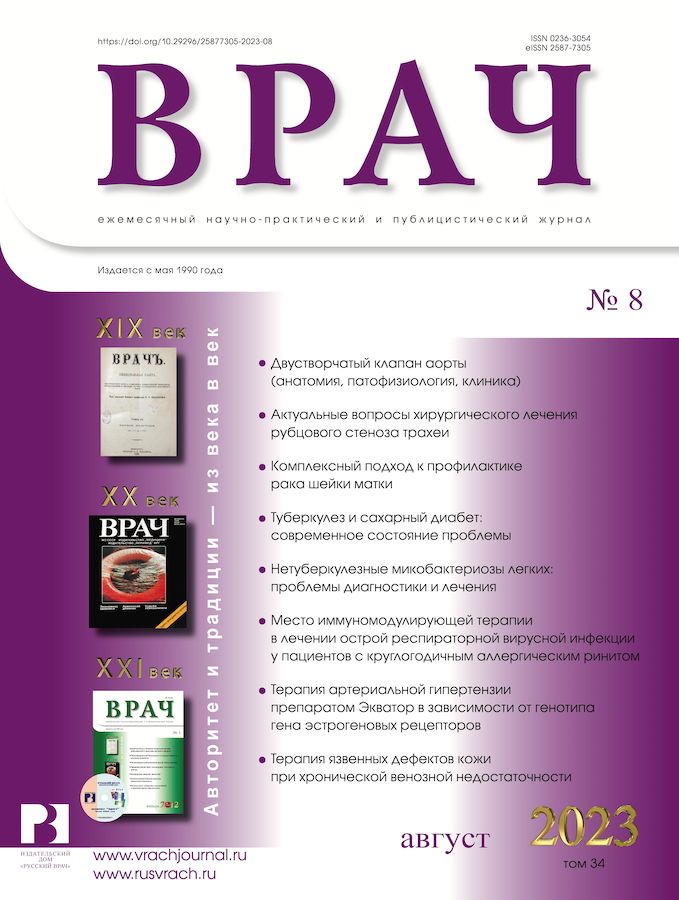Терапия язвенных дефектов кожи при хронической венозной недостаточности
- Авторы: Сакания Л.Р.1,2, Чех А.С.1, Корсунская И.М.2
-
Учреждения:
- Московский научно-практический Центр дерматовенерологии и косметологии Департамента здравоохранения Москвы
- Центр теоретических проблем физико-химической фармакологии РАН
- Выпуск: Том 34, № 8 (2023)
- Страницы: 79-81
- Раздел: Из практики
- URL: https://journals.eco-vector.com/0236-3054/article/view/569091
- DOI: https://doi.org/10.29296/25877305-2023-08-15
- ID: 569091
Цитировать
Полный текст
Аннотация
Хроническая венозная недостаточность (ХВН) характеризуется разно- образными симптомами и проявлениями, в том числе кожными, среди которых чаще всего встречается венозная экзема – примерно у 44% пациентов. Возникающий при экземе зуд приводит к расчесам, что, в свою очередь, повышает шансы развития вторичных инфекций. Кроме того, при ХВН часто развиваются венозные изъязвления нижних конечностей, которые также могут осложняться вторичной инфекцией, что затрудняет выбор терапии. В лечении венозной экземы используют комбинированные глюкокортикостероиды, которые снимают зуд и инфекционные осложнения, а также средства ухода с выраженным увлажняющим эффектом. При наличии язвенных дефектов необходимо примененять средства для очищения раневой поверхности и ускорения процессов эпителизации.
Ключевые слова
Полный текст
Об авторах
Л. Р. Сакания
Московский научно-практический Центр дерматовенерологии и косметологии Департамента здравоохранения Москвы; Центр теоретических проблем физико-химической фармакологии РАН
Автор, ответственный за переписку.
Email: marykor@bk.ru
ORCID iD: 0000-0003-2027-5987
кандидат медицинских наук
Россия, Москва; МоскваА. С. Чех
Московский научно-практический Центр дерматовенерологии и косметологии Департамента здравоохранения Москвы
Email: marykor@bk.ru
ORCID iD: 0009-0009-8985-3387
Россия, Москва
И. М. Корсунская
Центр теоретических проблем физико-химической фармакологии РАН
Email: marykor@bk.ru
ORCID iD: 0000-0002-6583-0318
доктор медицинских наук, профессор
Россия, МоскваСписок литературы
- Matić M., Matić A., Gajinov Z. et al. Major risk factors for chronic venous disease development in women: is childbirth among them? Women Health. 2019; 59 (10): 1118–27. doi: 10.1080/03630242.2019.1590492
- Lacroix P., Aboyans V., Preux P.M. et al. Epidemiology of venous insufficiency in an occupational population. Int Angiol. 2003; 22 (2): 172–6.
- Branisteanu D.E., Feodor T., Baila S. et al. Impact of chronic venous disease on quality of life: Results of vein alarm study. Exp Ther Med. 2019; 17 (2): 1091–6. doi: 10.3892/etm.2018.7054
- Serra R., Buffone G., de Franciscis A. et al. A genetic study of chronic venous insufficiency. Ann Vasc Surg. 2012; 26 (5): 636–42. doi: 10.1016/j.avsg.2011.11.036
- Serra R., Grande R., Butrico L. et al. Epidemiology, diagnosis and treatment of chronic venous disease: A systematic review. Chirurgia. 2016; 29: 34–45.
- Serra R., Grande R., Buffone G. et al. Chronic venous disease is more aggressive in patients with varicocele. Acta Phlebol. 2013; 14 (2): 57–60.
- Beebe-Dimmer J.L., Pfeifer J.R., Engle J.S. et al. The epidemiology of chronic venous insufficiency and varicose veins. Ann Epidemiol. 2005; 15 (3): 175–84. doi: 10.1016/j.annepidem.2004.05.015
- Serra R., Butrico L., Ruggiero M. et al. Epidemiology, diagnosis and treatment of chronic leg ulcers: a systematic review. Acta Phlebol. 2015; 16: 9–18.
- de Franciscis S., Nobile C.G.A., Larosa E. et al. Air contamination in the sclerosing foam for the treatment of varicose veins. Phlebology. 2016; 31 (2): 96–100. doi: 10.1177/0268355514565194
- Eklöf B., Rutherford R.B., Bergan J.J. et al. American Venous Forum International Ad Hoc Committee for Revision of the CEAP Classification. Revision of the CEAP classification for chronic venous disorders: consensus statement. J Vasc Surg. 2004; 40 (6): 1248–52. doi: 10.1016/j.jvs.2004.09.027
- Rabe E., Pannier F. Clinical, aetiological, anatomical and pathological classification (CEAP): gold standard and limits. Phlebology. 2012; 27 (Suppl 1): 114–8. doi: 10.1258/phleb.2012.012s19
- Serra R., Buffone G., Costanzo G. et al. Altered Metalloproteinase-9 expression as the least common denominator between varicocele, inguinal hernia and chronic venous disorders. Ann Vasc Surg. 2014; 28 (3): 705–9. doi: 10.1016/j.avsg.2013.07.026
- Amato B., Coretti G., Compagna R. et al. Role of matrix metalloproteinases in non-healing venous ulcers. Int Wound J. 2015; 12 (6): 641–5. doi: 10.1111/iwj.12181
- Serra R., Buffone G., Falcone D. et al. Chronic venous leg ulcers are associated with high levels of metalloproteinases-9 and neutrophil gelatinase-associated lipocalin. Wound Repair Regen. 2013; 21 (3): 395–401. doi: 10.1111/wrr.12035
- Tracz E., Zamojska E., Modrzejewski A. et al. Quality of life in patients with venous stasis ulcers and others with advanced venous insufficiency. Holist Nurs Pract. 2015; 29 (2): 96–102. doi: 10.1097/HNP.0000000000000072
- Yao P.Y., Mukhdomi T. Varicose Vein Treatment: Endovenous Laser Therapy. 2023 May 18. In: StatPearls [Internet]. Treasure Island (FL): StatPearls Publishing, 2023.
- Rzepecki A.K., Blasiak R. Stasis dermatitis: differentiation from other common causes of lower leg inflammation and management strategies. Curr Geriat Rep. 2018; 7 (4): 222–7. doi: 10.1007/s13670-018-0257-x
- Sundaresan S., Migden M.R., Silapunt S. Stasis dermatitis: pathophysiology, evaluation, and management. Am J Clin Dermatol. 2017; 18 (3): 383–90. doi: 10.1007/s40257-016-0250-0
- Theodosat A. Skin diseases of the lower extremities in the elderly. Dermatol Clin. 2004; 22 (1): 13–21. doi: 10.1016/S0733-8635(03)00113-X
- Payne D. Venous eczema: more than just a rash. Br J Community Nurs. 2023; 28 (6): 298–300. doi: 10.12968/bjcn.2023.28.6.298
- Kirkup M.E. Xerosis and stasis dermatitis. Preventive Dermatology. London: Springer, 2011; p. 71–9.
- Heilesen B. Studies on the therapeutic effect of trypsin. J Invest Dermatol. 1954; 23 (1): 7–15. doi: 10.1038/jid.1954.77
- Воронина Т.А. Мексидол, основные эффекты, механизм действия, применение. М., 2004; с. 21 [oronina T.A. Meksidol, osnovnye effekty, mekhanizm deistviya, primenenie. M., 2004; р. 21 (in Russ.)].
- Çakici N., Fakkel T.M., van Neck J.W. et al. Systematic review of treatments for diabetic peripheral neuropathy. Diabet Med. 2016; 33 (11): 1466–76. doi: 10.1111/dme.13083
Дополнительные файлы







